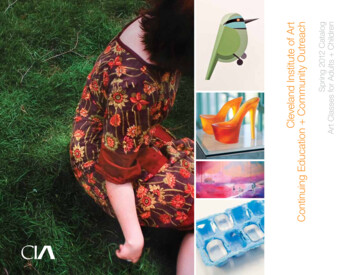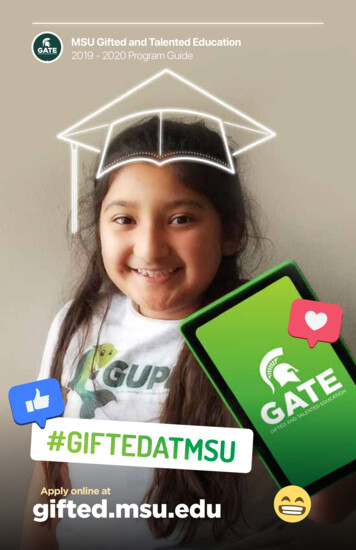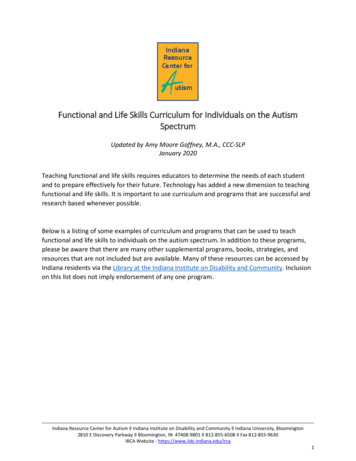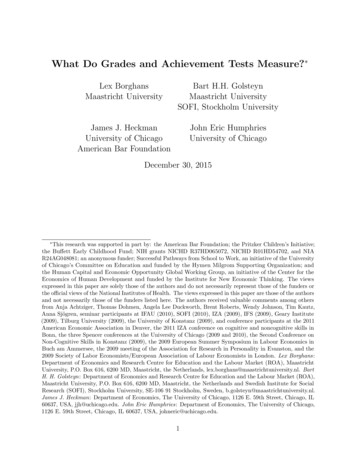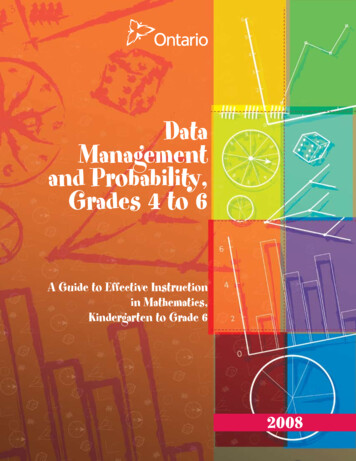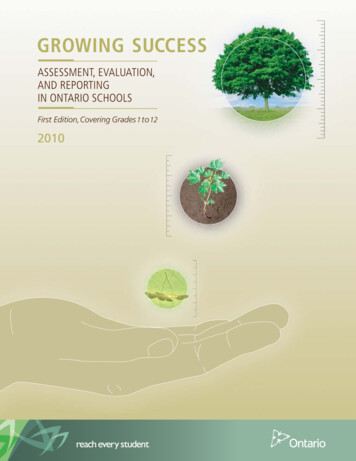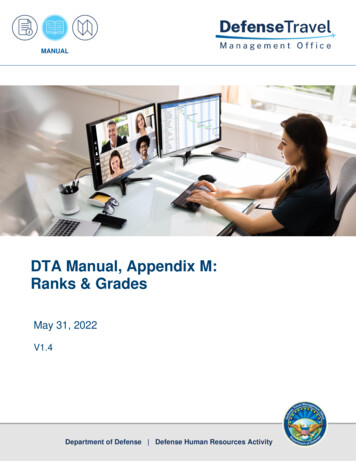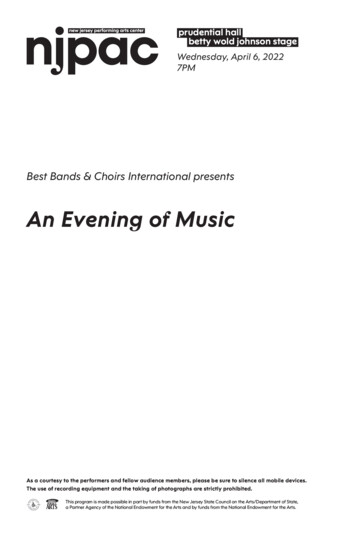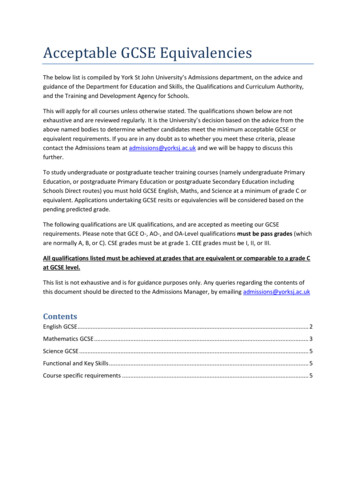
Transcription
Grades 3–4by Michael PriestleyNew York Toronto London Auckland SydneyMexico City New Delhi Hong Kong Buenos AiresHi-Lo Passages to Build Comprehension: Grades 3-4 Michael Priestley, Scholastic Teaching Resources
Scholastic Inc. grants teachers who have purchased Hi-Lo Passages to Build Comprehensionpermission to photocopy the designated reproducible pages from this book for classroom use.Notice of copyright must appear on all copies of copyrighted materials. No other part of thispublication may be reproduced in whole or in part, or stored in a retrieval system, or transmitted inany form or by any means, electronic, mechanical, photocopying, recording, or otherwise, withoutwritten permission of the publisher. For information regarding permission, write to Scholastic Inc.,557 Broadway, New York, NY 10012.Cover design by Maria LiljaInterior design by Creative Pages, Inc.Interior illustrations by Nicole in den BoschISBN: 0-439-54887-XCopyright 2005 by Michael Priestley. All rights reserved.Printed in the U.S.A.1 2 3 4 5 6 7 8 9 104010 09 08 07 06 05Hi-Lo Passages to Build Comprehension: Grades 3-4 Michael Priestley, Scholastic Teaching Resources
Hi-Lo Passages to Build ComprehensionGrades 3–4ContentsReadabilityA Note for Teachers. 4Level1. Rabbit Laughs (Story Elements).51.802. Here Comes the Sun (Sequence).61.903. Troll’s New Look (Story Elements) .71.954. Meet Jorge Estrella (Drawing Conclusions).91.985. Rules for Our School (Drawing Conclusions).112.006. Talk With Your Hands (Main Idea and Details).122.037. The Right Pet (Making Inferences and Predictions) .142.058. Peanut Butter Fudge (Sequence).152.109. The Snow Party (Making Inferences and Predictions).172.1510. Frieda and Her Trick (Details) .192.2011. Creepy Spiders (Drawing Conclusions).202.3012. Asteroid Just Misses Boy! (Cause and Effect) .222.3513. Riding the Board (Sequence) .232.3714. The Clean-Up Team (Cause and Effect) .252.4015. Sisters in Space (Cause and Effect).272.4316. The Very Hungry Kid (Story Elements) .292.4517. Snow Caves (Main Idea and Details).312.5018. Mama’s Magic Trick (Sequence) .322.5519. What Is a Whale? (Comparing and Contrasting).332.6020. What Did You Say? (Main Idea and Details) .352.6521. Bug Eaters (Comparing and Contrasting) .372.7022. A Second Chance for Seabiscuit (Cause and Effect).382.7523. Animal Baths (Comparing and Contrasting) .402.8024. Home Again (Story Elements).422.9025. Blair Elementary School News for March (Making Inferences and Predictions) .443.00Answer Key. 46Hi-Lo Passages to Build Comprehension: Grades 3-4 Michael Priestley, Scholastic Teaching Resources
A Note for TeachersReading is the key to learning, and today’s students read materials from anever-increasing number of sources. They must understand what they read intraditional forms of fiction and nonfiction, such as stories and textbooks. Theymust also comprehend newer forms of text, such as advertisements on Web sitesand e-mail on the Internet. Many students can benefit from more practice inreading, but finding good examples of hi-lo texts for instruction at differentgrade levels can be challenging.How to Use This BookThe main purpose of this book is to provide high-interest passages forstudents to read. All the passages in this book are intended to be motivatingand interesting for third- and-fourth grade students, but they are written forreaders one to two grade levels behind. You can find the readability score foreach passage in the table of contents. (Passages were scored using the Spachescoring criteria and range in level of difficulty from 1.80 to 3.0.) Thesepassages can be used for practice and instruction in reading, and they can beused to help prepare students for taking tests. Mostly, they can help studentsenjoy what they read.This book provides 25 grade-appropriate passages in a wide variety ofgenres, including nonfiction articles, stories, recipes, and interviews. Passagestarget comprehension skills, such as making inferences or comparing andcontrasting. Each passage has three or five comprehension questions based onskills. The questions are intended mainly to help students think about whatthey have read. (If you want to check students’ responses, you may refer tothe Answer Key at the back of the book.)These questions will also help you to assess students’ comprehension of thematerial. In addition, they will help students practice answering test questions.The types of questions include multiple-choice items and short-answer items.Some of the passages include writing prompts to elicit longer responses.Extending ActivitiesFor some of these passages, you may want to have students go beyondanswering the questions that are provided. For example, for any given passageyou could have students write a summary of the selection in their own wordsor rewrite the passage from a different point of view. For some pairs of texts,you might have students compare and contrast the two selections. For otherpassages, you might want to create writing prompts and have students writefull-length essays about what they have learned. Students will benefit fromreading and analyzing these passages, discussing them in class or in smallgroups, and writing about them in a variety of ways.4Hi-Lo Passages to Build Comprehension: Grades 3-4 Michael Priestley, Scholastic Teaching Resources
NameDatePassage 1Story ElementsLong ago, there lived a rabbit. Rabbit had a field. It was filled withweeds. Rabbit wanted to plant food. So she had to get rid of the weeds.But Rabbit was lazy. She did not want to pull up the weeds.Rabbit thought of a plan. She got a rope. She walked to one side ofthe field. There she found a big hippo. “I bet I can pull harder on thisrope than you!” Rabbit told Hippo. “Just hold one end. Wait until Istart to pull.”Then Rabbit took the other end of the rope. She walked to theother side of the field. There she found an elephant. “I bet I can pullharder than you!” Rabbit said. “Just hold this rope until I start to pull.”Rabbit went to the middle. She gave a tug on the rope. Hippo andElephant began to pull on each end. They pulled hard. The rope wentthis way and that. It cut down the weeds. Soon the weeds were gone!Rabbit hopped over to Hippo. “Thanks!” she said. Then she hoppedback to Elephant. “Thanks!” she said.Elephant and Hippo asked, “But whois pulling the other end of the rope if youare hopping?”How that Rabbit laughed!1. Where does this story take place?ABCDa seaa mountaina fielda zoo2. What was Rabbit’s problem?3. Which word best describes Rabbit?ABsadhelpfulCDmadtricky5Hi-Lo Passages to Build Comprehension: Grades 3-4 Michael Priestley, Scholastic Teaching Resources
NameDatePassage 2SequenceDo you like the sun? Here is a way to have a sun in your roomevery day!You will need: a paper plate a stapler some yellow paint a black pen a brush a hole punch yellow paper stringrStgin scissorsStep 1:Step 2:StepStepStepStepStep3:4:5:6:7:Paint the back of the plate yellow.Put your hand on the yellow paper. Drawaround your hand. Draw your hand 7 times.Cut out the 7 hands.Staple the hands to the plate.Draw a happy face on your sun.Make a hole at the top of the plate.Put string through the hole. Hang up the platein your room!1. What is the first thing you should do?2. What should you do after you draw your hand 7 times?3. What is Step 6?ABC6DMake a hole.Draw a happy face on your sun.Staple the hands to the plate.Cut out the 7 hands.Hi-Lo Passages to Build Comprehension: Grades 3-4 Michael Priestley, Scholastic Teaching Resources
NameDatePassage 3Story ElementsOnce there was a troll who lived under a bridge. Every day hescared people. That is what his father told him to do. That is what alltrolls do. Troll yelled, and people ran away.“Good job!” said his father.But Troll was very sad. His was a lonely job.“No one ever talks to me. No one ever smiles,” he said.“Of course not!” said his father. “You are a troll! No one will smileat you.”When Troll heard this, he sat under the bridge. He thought hewould never move again.The next morning, three girls came to the bank of the river. Trollknew he should yell and wave his arms. But he wanted to smile. Hewanted to tell them how pretty they looked. Then he rememberedwhat his father had told him. He yelled.“What was that?” screamed thebig sister.“It must be a monster!” screamedthe middle sister. They both ranback the way they had come.But the little sister looked underthe bridge. She saw Troll. “Who areyou?” she asked.“I am just a troll,” said Troll. “Noone will ever smile at me.”“Think about how you look,” saidthe girl.“What do you mean?” asked Troll.“If you sit under bridges and lookwild, people will not smile at you.They will be scared of you,” said thegirl. “You need to change the wayyou look!”7Hi-Lo Passages to Build Comprehension: Grades 3-4 Michael Priestley, Scholastic Teaching Resources
NameDate“How?” asked Troll.“You need to take a bath. Cut your hair. Wear some nice clothes!”Troll thought hard about what the girl said. Then he took a bathin the river. After that he walked into town. First he went to abarbershop. He said, “Please cut my hair.”“As you wish, Mr. Troll,” said the man.Next Troll bought some nice clothes. He paid with some fishfrom the river.“Thank you,” said the man in the store, and he smiled at Troll!That made Troll smile to himself all the way home.1. At the beginning of the story, where is Troll?ABCDunder a bridgein a storein a houseon an island2. What is Troll’s problem?3. How does Troll solve his problem?4. Where does Troll walk to near the end of the story?5. How does Troll feel at the beginning of the story, and howdoes he feel at the end?8Hi-Lo Passages to Build Comprehension: Grades 3-4 Michael Priestley, Scholastic Teaching Resources
NameDatePassage 4Drawing ConclusionsJorge Estrella writes for anewspaper. He works for Big SkyNews. We spoke to him to find outabout his job.facts. I ask them questions. Then I goback to the building where I work. It’sfilled with people. The people are allworking on the next day’s newspaper.Question: How long have you beenwriting news stories?Q: Do you think your job is hard?Answer: I have been writing fortwo years.Q: Why did you becomea writer?A: I have always liked towrite. When I was a kid,I wrote lots of stories.Q: So why do youonly write newsstories now?A: When you write astorybook, you spend a lotof time alone. I want to havemany chances to meet people andtalk to them. That’s why I write news,not books.Q: How do you spend time withother people as a news writer?A: Before I write a story, I have to getfacts. I see the people who know theA: Some days are harder thanothers. On a hard day, many thingshappen. That means I have towrite a lot of news stories.Sometimes I even misslunch! But at the end ofa hard day, I feel goodabout all of my work.Q: Do you ever writenews stories aboutkids?A: Sure. I am working onone right now. It’s aboutsome kids who think thecity needs more soccer fields.They want to find a way to getmore fields.Q: What do you think will happen?A: Well, many people will read mystory. Maybe some of them will offerto help. If they do, that will beanother story I can write.9Hi-Lo Passages to Build Comprehension: Grades 3-4 Michael Priestley, Scholastic Teaching Resources
NameDate1. Big Sky News is the name of aABCD.newspapermystery booksongcollege2. From reading this passage, what can you tell aboutJorge Estrella?ABCDHe likes to be alone.He likes to play soccer.He likes to write books.He likes to be around people.3. Where do you think Jorge writes his news stories?4. What would an easy day at work be like for Jorge?5. To write a story about the kids who want more soccer fields,what does Jorge need to do?ABCDMeet and talk to people.Read a soccer book.Watch the kids play soccer.Give the kids a soccer field.10Hi-Lo Passages to Build Comprehension: Grades 3-4 Michael Priestley, Scholastic Teaching Resources
NameDatePassage 5Drawing Conclusions1. SMILE. People catch smiles3. ALWAYS SAY THANK YOU.Remember to say “Thank you” toothers. The person you thank willfeel good. The person will also beglad to help you the next time.just like they catch colds! If yousmile at a person, he or she willprobably smile at someone else.Soon the whole school will besmiling.4. NEVER PUSH. Lots of people2. FIND WAYS TO HELP. If someoneshare our school. We share thehalls. We share the water fountains.You can’t always be first. So do notpush! You will make others angry.You might even hurt someone.Instead, say, “You first!”falls, help that person up. Ifsomeone has a lot of books,open the door. If a friend doesnot understand something,help him or her.1. Why do you think you should smile?ABCDIt can help make others happy.Smiles are hard to catch.Few people know how to smile.The school will not catch cold.2. What is one rule that you should NOT add to “Rules forOur School?”ABDon’t push others in line.Share with other students.CDDon’t help new students.Always say “Please.”3. What lesson did you learn from these rules?Writing Prompt: Do you think these rules would be good for yourschool? Why or why not?Hi-Lo Passages to Build Comprehension: Grades 3-4 Michael Priestley, Scholastic Teaching Resources11
NameDatePassage 6Main Idea and DetailsSome people can’t hear. These people have a special way oftalking. They talk with their hands. This is called “signing.” Thereare two main ways to sign. First, you can spell out each letter in aword. Here is the word love.Spelling words takes a long time. There is a faster way to sign.You can show a whole word with one sign.To sign some words, you keep your hands still. (Look at thesigns for love and ball below.) To sign other words, you need tomove your hands. To sign the word dog, you pat your leg.Signing is lots of fun. Anyone can learn. You can learn from abook. You can learn from a teacher. You can learn from a friendwho uses signing every day. Here are good signs to start with:12Hi-Lo Passages to Build Comprehension: Grades 3-4 Michael Priestley, Scholastic Teaching Resources
NameDate1. What is this passage mostly about?ABCDhow to be a better spellerwhy some people cannot hearall the things you can do with your handsusing your hands to talk2. Look at the sign. What letter is it?ABCDLOVE3. What word does this sign stand for?4. Name a word that you have to move your hands to sign.5. There are many ways to learn how to sign. Name two.13Hi-Lo Passages to Build Comprehension: Grades 3-4 Michael Priestley, Scholastic Teaching Resources
NameDatePassage 7Making Inferences and PredictionsWill sat on the kitchen floor. He washolding a cookie next to a tiny hole in thewall. Will’s father came into the kitchen.“What are you doing?” he asked.“Quiet, please,” said Will. “You willscare it.”“What will I scare?” askedWill’s dad.“The mouse!” said Will. “This is amouse hole.”“That hole does not belong to a mouse,” said his dad. “I made it.”“How?” asked Will.“I banged a chair leg into the wall. I am going to fix the hole,”said his dad.Will looked at his father. Then he looked down at the floor.“What is wrong?” asked his father.Will said, “Cats make Mom sick. Our apartment is too small for adog. I thought I had found a pet at last.”His father smiled. “Wild animals do not make good pets, Will. I havea better idea. Would you like to go to the pet store?”“Of course,” Will said as he stood up. He put the cookie in hismouth. He was ready to go.1. Why do you think Will was holding a cookie?2. How do you think Will felt when he looked down at the floor?ABhappysurprisedCDtiredsad3. What do you think Will and his father will do next?ABMake a hole in the wall.Get a mousetrap.CDBuy a pet mouse.Make some cookies.14Hi-Lo Passages to Build Comprehension: Grades 3-4 Michael Priestley, Scholastic Teaching Resources
NameDatePassage 8SequencePeanut Butter FudgeDo you love peanut butter? Here is a way to make a soft peanutbutter fudge. Ask an adult to help you when you use the microwave.Do not make this if you cannot eat peanuts.Peanut Butter FudgeA Recipe ForYOU WILL NEED: 1 stick of butter a cake pan 1 cup of peanut butter a large bowl that can peanuts 4 cups of sugar 1 2 cup of milk 1 cup of chocolate chipsStep 1: Let the butter get soft.Rub a little butter all overthe sides of the cake pan.Step 2: Put the rest of the butterin the bowl. Add thepeanut butter. Put thebowl in the microwave.Put it on high for twominutes.Step 3: Take the bowl out of themicrowave. Stir well.Step 4: Crush the peanuts intolittle pieces. You can dothis with a rolling pin.go in the microwave a big spoon a rolling pin measuring cupsStep 5: Put the crushed peanutsinto the bowl. Add thesugar and the milk. Addthe chocolate chips. Stireverything together.Step 6: Put the bowl back in themicrowave. Turn it onhigh for 1 minute.Step 7: Take the bowl out andstir well.Step 8: Pour the fudge into thecake pan. Cool the panfor one hour.Step 9: Cut the fudge into pieces.Eat and ENJOY!15Hi-Lo Passages to Build Comprehension: Grades 3-4 Michael Priestley, Scholastic Teaching Resources
NameDate1. What is the first step?ABCDHeat the peanut butter.Add the milk.Butter the pan.Stir well.2. What do you do right before you add the peanut butter?ABCDStir well.Put the butter in the bowl.Add milk.Add the chocolate chips.3. What do you do in Step 4?4. What do you do in Step 7?5. What do you do just after you pour the fudge into thecake pan?16Hi-Lo Passages to Build Comprehension: Grades 3-4 Michael Priestley, Scholastic Teaching Resources
NameDatePassage 9Making Inferences and PredictionsAmy and Hana woke up early on Monday. There was a loudnoise out in the street. It was the plow going by! There was snowoutside. Then there was a knock on the twins’ door.“There’s no school today!” said Mom.The girls smiled.“Then let’s go outside,” they said.After breakfast, the twins put on their snow pants and coats.Then they went across the street to the Arnolds’ house.Amy knocked, and Mr. Arnold opened the door.“Hi, girls,” he said.“Are you going to have a snow party today?” asked Hana.“We always do!” said Mr. Arnold. “Go get your sleds!”The Arnolds had a big hill behind their house. It was great forsledding. There was just one problem. At the bottom of the hillwas a fence. If you thought you might hit the fence, you had toroll off your sled.Mr. Arnold went down the hill first. His sled made a safe paththrough the snow.17Hi-Lo Passages to Build Comprehension: Grades 3-4 Michael Priestley, Scholastic Teaching Resources
NameDateMrs. Arnold went next. She did not steer very well and had to rolloff. When she came up the hill, she looked like a snow woman! Thetwins laughed.Hana had a great run. She steered just right. Amy clapped.Then it was Amy’s turn. She jumped on her sled. She started downthe big hill. She went so fast! The snow flew up into her face! Wherewas the path?“Jump!” Mr. Arnold yelled.Amy took a deep breath. She let go of her sled.1. Why did Amy and Hana smile after they learned schoolwas closed?ABCDThey were tired.They were mad.They were happy.They were hungry.2. Why did the girls laugh after Mrs. Arnold’s run?ABCDMrs. Arnold looked funny.Mrs. Arnold looked cold.Mrs. Arnold looked scared.Mrs. Arnold looked sad.3. Why did Amy clap after Hana’s run?ABCDShe was glad Hana had a good run.She wanted to warn Hana about the fence.She knew her turn would be next.Her hands were cold.4. Why did Amy take a deep breath at the end of the story?5. What do you think Amy did next?18Hi-Lo Passages to Build Comprehension: Grades 3-4 Michael Priestley, Scholastic Teaching Resources
NameDatePassage 10DetailsFrieda lives in Germany. Frieda is an octopus. Every daypeople come to the zoo to see Frieda. They come to see herspecial trick.An octopus has eight arms. Friedauses these arms to do her trick. Sheopens jars! Here is how she does it.People at the zoo put food thatFrieda likes in a jar. They put thelid on tight. Then they place the jarin the water with Frieda.This smart little octopus climbson the jar. She holds the lid withher arms. Then she turns her body.The lid comes off!People at the zoo think Friedasaw them open jars. Then she did itherself. Frieda only opens the jarswith food that she likes!1. Where does Frieda live?2. What is in Frieda’s jars?3. Frieda holds the lid with herABCD.headarmsmouthtail19Hi-Lo Passages to Build Comprehension: Grades 3-4 Michael Priestley, Scholastic Teaching Resources
NameDatePassage 11Drawing ConclusionsMany people are a little afraid of spiders. This makes sensebecause some spiders can hurt people. But most spiders are safe.It is important to know that.Ann Blaine was not just a little afraid of spiders. Every time shesaw a spider, Ann screamed. She cried. She fell down. She wasthat scared!If the spider was in her house, she had to leave. She would stayat a friend’s house until her family caught the spider! Once she didnot come home for a month!Ann went to a doctor. Ann’s doctor told her that lots of peopleare afraid of things. He said she could get help. He sent her to aspecial doctor who helps people who are afraid a lot of the time.First, Ann had to look at pictures ofspiders. To her surprise, she slowly gotused to them. Next, Ann had to look atvideos of spiders. Then, the doctor gaveAnn’s family a big, toy spider. Their job wasto hide it in the house. Poor Ann! Comingacross the toy spider in strange places wasnot fun!Finally, the doctor said Ann was ready for a bigtest. He put some real spiders in front of Ann. Thespiders were in jars. They were very tiny spiders. Thenthe spiders were let loose. Ann made herself touch one.She even let one run on her hand.Ann is still a little afraid of spiders.But if she finds one at home, she doesnot have to move away for a month.She can catch the spider in a jarand put it outside—all by herself.20Hi-Lo Passages to Build Comprehension: Grades 3-4 Michael Priestley, Scholastic Teaching Resources
NameDate1. Why do you think Ann Blaine went to a special doctor?2. Why do you think the doctor made Ann look at pictures ofspiders?3. Why do you think Ann was ready for the big test at the endof the story?ABCDShe could put spiders in jars.She could hide toy spiders in her house.She could let spiders run on her hand.She wasn’t afraid of toy spiders anymore.4. Do you think the special doctor helped Ann? Tell why orwhy not.5. Think of something else a person might be afraid of.How would you help this person if you were a doctor?How would you get the person used to the thing so it didnot seem so scary?21Hi-Lo Passages to Build Comprehension: Grades 3-4 Michael Priestley, Scholastic Teaching Resources
NameDatePassage 12Cause and EffectSeptember 1, 1991Noblesville, Indiana —Last night, Brodie Spaulding wasstanding outside his house. He hearda strange sound. Then a small rock hitthe ground. It was black and brown.When Brodie touched the rock, hewas surprised. The rock was warm!Brodie’s rock was very special. Itcame all the wayfrom space toBrodie’s yard!Space is full ofrocks. They arecalled asteroids. Highin the air, the asteroidcatches on fire. Haveyou ever seen ashooting star in the night sky? It isreally a burning space rock. Most ofthese rocks burn up before they reachEarth. Only a few hit the ground.The rock in Brodie’s yard was stillwarm because it had just been on fire!The rock hit Earth hard because itwas moving veryfast. It made a holein Brodie’s yard.Brodie feltscared. The rockalmost hit him!He also felt lucky.Now he owned aspace rock!1. Why was Brodie surprised when he touched the rock?ABIt was brown.It was black.CDIt was small.It was warm.2. Why did the asteroid make a hole in Brodie’s yard?3. Why did Brodie feel scared about the asteroid?22Hi-Lo Passages to Build Comprehension: Grades 3-4 Michael Priestley, Scholastic Teaching Resources
NameDatePassage 13SequenceYoko stepped on her skate board and pushed off. But this timesomething went wrong. Her board flew out from under her. As shestarted to fall, she put out her arm and fell hard on it.Yoko rubbed her arm. She waited for the hurting to stop, but itdid not. Then Yoko tried to move her arm. It hurt even more.She looked across the park. Dad was reading a book.She got up and she walked toward Dad. She held her arm still asshe walked, but it still hurt a lot.Now Yoko was crying. Dad moved Yoko’s hurt arm just a little bit.“Ow!” shouted Yoko. “That hurts!”Dad took Yoko to the doctor. Dr. Rio took an X-ray of Yoko’s arm.She showed it to Yoko and her dad. The X-ray showed that Yoko’sarm bone was broken.“But I was wearing my arm pads,” said Yoko. “How could I breakmy arm?”“You held your arm out and landed on it. That’s why it broke,”said Dr. Rio. “Next time hold them close to your body.”“That’s an important thing to know,”said Dad.“Yes,” said Dr. Rio. “We often learn bestfrom the mistakes we make.” Then shesmiled at Yoko. “Now, let’s put a caston that arm of yours.”23Hi-Lo Passages to Build Comprehension: Grades 3-4 Michael Priestley, Scholastic Teaching Resources
NameDate1. What happened first in this story?ABCDYoko’s board flew out from under her.Yoko fell on her arm.Yoko pushed off.Yoko stepped on her board.2. What did Yoko do just before she fell?3. Which of these happened first?ABCDDad took off Yoko’s helmet and pads.Yoko rubbed her arm and tried to move it.Yoko got up and walked toward Dad.Yoko started crying.4. What happened next after Dad brought Yoko to the doctor?ABCDDad tried to move Yoko’s arm.Yoko asked, “How could I break my arm?”Dr. Rio took an X-ray of Yoko’s arm.Yoko’s arm stopped hurting so much.5. After Dr. Rio took an X-ray, what did she do next?24Hi-Lo Passages to Build Comprehension: Grades 3-4 Michael Priestley, Scholastic Teaching Resources
NameDatePassage 14Cause and EffectMrs. Gill lived next door to Nita. Every afternoon, Mrs. Gill tooka walk. She said it kept her young. Nita liked to peek out whenMrs. Gill came back. Mrs. Gill was always happy after her walk. Sheoften showed Nita something she had found, like a bright red leaf.One afternoon, Mrs. Gill looked sad. Nita asked her what waswrong.Mrs. Gill held up a can. “I am sad about all the trash on thestreet,” she said. “I have never seen so much trash in thisneighborhood! What has happened?”“Mr. Trent moved,” said Nita. “He used to go out each morningand pick up trash. I often saw him on my way to school.”Mrs. Gill looked surprised. “I thought I knew everything aboutthis neighborhood!” she said. “But you see more than I do!”“I wish I could do Mr. Trent’s job, but my back is stiff. It’s hardfor me to bend over and pick things up.”“I could do that,” said Nita.Mrs. Gill smiled. “I will carry the trash bag! You can use mygardening gloves so your hands stay clean.”Nita put on the gloves. She picked up pieces of paper. Shepicked up cans. Lots of people stopped to thank Mrs. Gill and Nita.The street looked much better when Nita and Mrs. Gill were done.“Thanks, Nita,” said Mrs. Gill. “Let’s call ourselves the cleanup team!”25Hi-Lo Passages to Build Comprehension: Grades 3-4 Michael Priestley, Scholastic Teaching Resources
NameDate1. Why did Mrs. Gill take a walk every day?ABCDShe wanted to pick up litter.She wanted to talk to Mr. Trent.She wanted to feel young.She wanted to start a club.2. Why was Mrs. Gill sad one day?ABCDShe lost a red leaf.The streets were full of trash.She lost her gloves.Nita was bothering her.3. Why did the neighborhood have so much trash?4. Why did Nita pick up the trash instead of Mrs. Gill?5. Why did Nita’s hands stay clean?26Hi-Lo Passages to Build Comprehension: Grades 3-4 Michael Priestley, Scholastic Teaching Resources
NameDatePassage 15Cause and EffectSistersinSpaceVenus is close to Earth. It is the second planet from the sun.Earth is third from the sun. Venus and Earth are almost the samesize. That’s why Venus is called Earth’s “sister planet.”Scientists have been learning about Venus for a long time. Firstthey look
Name Date 5 Passage 1 Story Elements Long ago, there lived a rabbit. Rabbit had a field. It was filled with weeds. Rabbit wanted to plant food. So she had to get rid of the weeds.

